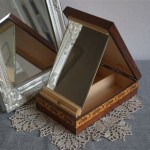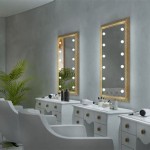```html
Painting A Mirror: Techniques, Preparations, and Considerations
Painting a mirror is a technically challenging task that requires careful preparation and an understanding of the materials involved. While one might question the purpose of covering a reflective surface with opaque paint, the practice serves multiple purposes, ranging from creating decorative effects and artistic expressions to restoring damaged mirrors and concealing imperfections.
The process is considerably different from painting conventional surfaces like canvas, wood, or walls. The inherent smoothness and non-porous nature of glass require specialized primers and paints designed to adhere securely and prevent peeling or chipping. Failure to adhere to proper techniques can result in unsatisfactory and often unstable results.
Preparing the Mirror Surface
Proper preparation is paramount to achieving a successful and durable paint job on a mirror. The initial step involves a thorough cleaning of the mirror surface. Cleaning should be performed using a glass cleaner free of ammonia and other harsh chemicals that could leave a residue. The surface must be completely free of dust, grease, fingerprints, and any other contaminants.
After cleaning, the mirror should be inspected for any existing damage, such as scratches, cracks, or silvering degradation. Minor scratches may be addressed with specialized glass polishing compounds, but more significant damage might necessitate professional repair or replacement depending on the desired outcome. Attempting to paint over significant damage is unlikely to produce a visually appealing result.
Once the mirror is clean and any necessary repairs are made, masking is crucial. Areas that are not intended to be painted, such as the frame or specific sections of the reflective surface, must be carefully masked off using high-quality painter's tape. The tape should be applied firmly and evenly to prevent paint bleed. For intricate designs, liquid masking agents can be employed, offering greater precision than tape in certain applications.
Following masking, the application of a suitable primer is essential. Primer serves to create a bonding surface for the paint, significantly improving adhesion and preventing peeling. Select a primer specifically designed for glass or non-porous surfaces. Epoxy primers or those containing adhesion promoters are generally recommended. Apply the primer in thin, even coats, following the manufacturer's instructions regarding drying time and recoating.
Selecting the Right Paint
The choice of paint is another critical factor in achieving a desirable outcome. Traditional latex or acrylic paints, which are commonly used on walls and other porous surfaces, are generally unsuitable for mirrors due to their poor adhesion on glass. Specialized paints designed for glass, or paints with enamel additives, are better options.
Epoxy paints offer excellent adhesion and durability, making them a suitable choice for mirrors that are likely to be subjected to wear and tear. However, epoxy paints often require a two-part mixing process and may emit strong odors during application. Proper ventilation is essential when working with epoxy paints.
Enamel paints provide a smooth, durable finish and are available in a wide range of colors. They also offer better resistance to chipping and scratching compared to standard latex or acrylic paints. When using enamel paints, selecting a self-leveling formula can help minimize brushstrokes and ensure a smoother, more uniform appearance.
For decorative effects, translucent or transparent paints can be used to create unique designs that allow some of the mirror's reflectivity to show through. These paints are often used in stained glass techniques or to create artistic overlays on the mirror surface. Experimenting with different colors and layering techniques can produce visually stunning results.
Aerosol paints designed for glass are a convenient option for smaller projects or intricate designs. These paints offer good coverage and can be applied in thin, even coats. However, it is important to use proper ventilation when working with aerosol paints, and overspray should be carefully controlled to avoid contaminating surrounding surfaces.
Application Techniques and Considerations
The application technique significantly affects the final appearance of the painted mirror. Whether using a brush, roller, or spray gun, it's crucial to apply the paint in thin, even coats. Multiple thin coats are preferable to a single thick coat, as this minimizes the risk of drips, runs, and uneven drying.
When using a brush, choose a high-quality brush with soft bristles to minimize brushstrokes. Apply the paint in long, smooth strokes, overlapping each stroke slightly to ensure uniform coverage. Avoid pressing too hard on the brush, as this can cause the bristles to splay and leave visible marks.
Rollers can be used to achieve a smoother, more uniform finish, particularly on larger mirror surfaces. Select a roller with a short nap to minimize stippling. Apply the paint in a consistent direction, overlapping each pass to avoid streaks.
Spray painting offers the most even and professional-looking finish, but it requires specialized equipment and technique. Use a spray gun with adjustable settings to control the flow of paint and the spray pattern. Hold the spray gun at a consistent distance from the mirror surface and move it in smooth, even strokes. Overlapping each pass by approximately 50% ensures uniform coverage and prevents streaks.
Drying time is a critical factor to consider. Allow each coat of paint to dry completely before applying the next coat. Follow the manufacturer's instructions regarding drying time and recoating. Rushing the drying process can lead to paint defects, such as peeling, blistering, or cracking.
After the final coat of paint has dried completely, carefully remove the masking tape. Pull the tape away from the painted surface at a 45-degree angle to minimize the risk of chipping or peeling the paint. If any paint has seeped under the tape, use a sharp blade (like a razor blade) to carefully score the edge of the paint film before removing the tape.
The painted mirror should be allowed to cure for several days before being handled or cleaned. Curing allows the paint to fully harden and develop its maximum durability. Avoid using harsh cleaning chemicals on the painted surface. Clean the mirror with a mild soap and water solution and a soft cloth.
Beyond the technical aspects, consider the environmental conditions during the painting process. Temperature and humidity can significantly impact the drying time and adhesion of the paint. Ideally, painting should be performed in a well-ventilated area with moderate temperature and low humidity. Avoid painting in direct sunlight, as this can cause the paint to dry too quickly and lead to defects.
Addressing Potential Problems
Despite careful preparation and execution, problems can sometimes arise during the mirror painting process. One common issue is paint peeling or chipping. This is often caused by inadequate surface preparation, the use of an inappropriate primer, or inadequate drying time between coats.
If paint peeling occurs, the affected areas should be carefully scraped or sanded down to the bare glass. The surface should then be cleaned and primed again before repainting. Ensure that the primer and paint are compatible and that sufficient drying time is allowed between coats.
Another potential problem is uneven paint coverage, which can result in streaks, blotches, or variations in color. This is often caused by improper application technique or the use of a low-quality paint. Applying multiple thin coats of paint, using a high-quality brush or roller, and ensuring proper lighting can help prevent uneven coverage.
If uneven coverage occurs, additional coats of paint may be necessary to achieve a uniform appearance. Light sanding between coats can help smooth out any imperfections and improve the adhesion of subsequent coats.
Bubbles or blisters in the paint film can also occur, often due to trapped air or moisture. This can be caused by inadequate surface preparation, the application of too thick a coat of paint, or painting in humid conditions. To prevent bubbles, ensure that the mirror surface is completely dry before painting, apply the paint in thin coats, and avoid painting in high humidity.
If bubbles appear, they can be carefully punctured with a needle or pin and then smoothed out. Alternatively, the affected area can be sanded down and repainted.
Finally, runs or drips can occur, particularly when using spray paint or applying too much paint at once. To prevent runs, apply the paint in thin, even coats, and avoid holding the spray gun too close to the mirror surface.
If a run occurs, allow the paint to dry completely, then carefully sand down the run until it is flush with the surrounding surface. Clean the area and apply a thin coat of paint to blend it in.
```
Painting On Mirrors An Easy Step By Guide

Spray Painted Rainbow Mirror Makeover Colorshot Paint

O Gorgeous Mirror Makeover With Chalk Paint Vinyl

How To Spray Paint A Mirror Step By Guide

12 Techniques To Painting Antique Mirrors Hallstrom Home

Mirror Painting Painted Art Aesthetic

How To Paint A Mirror Frame Salvaged Inspirations

12 Techniques To Painting Antique Mirrors Hallstrom Home

How To Spray Paint A Mirror

Acrylic Painting On Mirror Artph Acrylicpainting Acryliconmirror Supportlocal Underr Painted Art Flower








